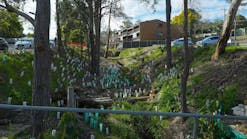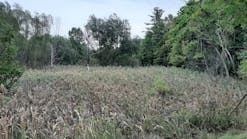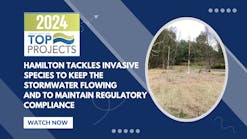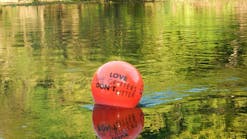It probably goes without saying: If the site was perfect, it likely wouldn’t need erosion control. Good soil, good drainage, a gentle slope or none, plenty of vegetation-in real life, that’s the “after” photo. No wonder your work is so challenging! It’s often difficult enough to get control measures in place on a “natural wear” site; adding the stressors of heavy equipment or wildfire makes the task that much harder. So, pity the poor seed that tries to get established on such a site. Moisture’s a must for germination, and compacted or sparse topsoil makes it difficult to set down roots. Thankfully, many erosion control suppliers and contractors have a wide array of products to choose from that give those seeds and sites a fighting chance.
Cotton to a Seed’s Every Need
Erosion control specialist Van Vermeesch of Aqua Flo Supplies in Ventura, CA, provides products to landscapers, property managers, and those in construction. “There are a couple different things we sell, such as the blankets which North American Green is famous for,” he says. “They carry a lot of different ones for different applications, but there’s also the spray-as-you-go kind.”
Vermeesch refers to North American Green’s HydraMatriCx Series high-performance hydraulic erosion control products, which are made with a proprietary blend of straw, reclaimed cotton plant material, tackifiers, and polymers. Designed to replace temporary erosion control blankets, HydraMatriCx products feature a one-step application of seed, fertilizer, and mulch with no synthetic fibers.
“We’ve had some fires out here, mostly on steep slopes,” he says. “The vegetation’s been entirely burned off, so there’s no erosion control in place. Our first recommended step: Apply HydraCX2 Extreme Slope Matrix, which works well on 1:1 and 2:1 slopes. With a hydroseeding machine, one can shoot it, even on rough terrain, from a couple different angles. After coating the ground, the solution will bind with soil particles, creating an excellent growing medium for existing seed or whatever is planted there. As many California areas prefer wildflowers, and there’s pressure to remove non-native species, we can put those seeds right in the mix and they can be distributed over the area. We usually buy seeds from S&S Seeds, which is known for its native seeds.
“Many times, the California agencies say don’t put in new seeds-just get the local seeds to grow,” he continues. “In Griffith Park [Los Angeles] last year, they didn’t add seed after the fire; they went with the seeds already fallen from the native plants. Many projects are not using grasses, but more native seeds. As erosion control is vegetation, it’s best to use the most effective means. You need to look at the area. Is there a chance native seeds will do the job? Have we determined there will be enough, or do we have to add seeds?”
Performing tasks for residential clients can also become color specific: “Some homeowners have been known to ask for specific colors of plants: “˜I don’t want the orange California poppy, I want blues and purples.'”
After 2008’s wildfires, fast action was needed. “Sediment starts moving after a fire, especially if it’s dosed with water, because there’s nothing to hold it back. We suggest using blankets or HydraCX2, which gives a flexible blanket and 12 months of protection, while providing an excellent environment for germination to occur. In the case of wildfires, which usually occur in the fall, the state also gets rain in the winter-which means the site is not only dealing with gravity but also the momentum of rain.”
Vermeesch views erosion control and sediment control as different processes. “Erosion control is stabilizing an area. Erosion control may be done upstream from the sediment problem. If erosion control is done correctly, you don’t have a sediment problem. HydraCX2 and HydraCM, which works on medium-length, moderate-to-steep slopes (4:1 to 3:1), promote holding moisture. They will even wick moisture into the soil, making a soft shell over the ground, to catch the raindrop energy. The site can then utilize that moisture to dampen the soil, promoting germination but still holding the soil in place. Erosion doesn’t correct itself. You can slow that whole process.”
North American Green products also use less water during application. “We can put more product in the tanks, and it’s favorable for the contractor. As North American Green products are cotton-based products with straw, they’re nontoxic and completely biodegradable.”
He explains what can happen if the site’s not protected: “Rills-vertical cuts into the mountain-turn into gulleys, which don’t go away. When treating a slope, you can use additives other than seed and mulch, and soil sampling is advisable. Anything needed to change the soil’s pH can be added to the mulch and broadcast evenly.
“When using natural fibers, the carbon-to-nitrogen ratio is usually already exactly what’s needed for the soil; you don’t need to “˜thin out’ the carbon after a fire,” he continues. “When we compare different mulches, we see different carbon-to-nitrogen ratios. Wood fibers usually absorb nutrients, then you have to add a fertilizer. Cotton fibers are not bulky and are nitrogen-rich, so you can use less fertilizer. We discovered this in test plots-in some we added fertilizer, and in others, we said, “˜Let’s see what happens if we don’t add it.’ If we do add fertilizer, we use a 15-15-15. North American Green products require less fertilizer. Wood-based mulch has a carbon-to-nitrogen ratio of 300:1; what we’re using is more like 40:1 ratio. There’s less biomatter to break down, and the mulch is made of something a plant can more easily use.”
Two months after the November 2008 fires, Vermeesch already noticed new growth on the formerly charred hillsides. “As many native seeds need heat to germinate, or need old-growth burn-off so they can flourish, the fires start another growing process. It’s just a shame that so many homes got caught up in this cycle of life. A great effort is needed to make sure homes on slopes don’t wash down; we must do whatever we can to promote vegetation.”
A Fundamental Fungus
Water, sun, and good soil do the trick for most plants, but some need a little extra help. Mycorrhizal fungi, which attach themselves to plant roots, help attract vital nutrients in the soil, which in turn feed the plant. Healthier plant, healthier soil-holding roots-an erosion controller’s dream! Yet some soils lack, or have lost, mycorrhizal fungi, so these herbal helpers have to be incorporated into the ground.
Madison, GA’s Pennington Seed Inc. has teamed up with Mycorrhizal Applications Inc. of Grants Pass, OR, to streamline this process. Instead of going through a two-step application (mycorrhizae, then seeds), Pennington has included the mycorrhizae in the mix.
“Tests have been done in Georgia, Arizona, and Texas, using plants specially chosen for the Southwest and deep Southeastern environments,” says Pennington’s Russ Nicholson, CPAg. “For Texas, our mix includes Bermuda and Bahaia grasses and Durana clover. This clover is a cool-season legume, which fixes nitrogen from the atmosphere into the soil, making it available to the plants. The result is more perpetual plants with less maintenance. Durana clover, a bushy-type with white flowers that grows to about knee-high, has up to 97 stolons per square foot; other clovers have about 50. Durana clover fixes up to 100 pounds of nitrogen to the acre-all the nitrogen that’s necessary for the tall fescue. There’s a symbiotic relationship between this and the other grasses, and with mycorrhizae, which grabs the phosphorus and potassium in the soil and brings it in for the plants. Pennington’s SlopeMaster, which is what we call this mix, makes the planting self sustaining.” Other mixes have been prepared for different areas, such as the mid-north and the prairies of the mid-south.
All the plants included in the seed mix are deep rooted and quick to establish, which make them perfect for an erosion control mix. “The clover grows slowly, but Bermudas and fescues are up and going in three weeks; by 45 days you have good ground cover,” Nicholson says. “For a tough site, one might use a nurse crop, like an annual rye or millet, adding that to the mix. For example, we ran tests on a temporary soil stockpile in Florida that was a couple hundred feet tall-a 1:1 slope. We didn’t want a nurse plant to germinate, grow tall, and fall over, so we used a cereal rye, which allowed the sun to reach the soil, to germinate the other three plants.”
Adding mycorrhizae to the seed mix makes the resultant plants work more effectively. “Along with phosphorus and potassium, it attracts glomulin, which is like a glue that binds the nutrients to the plant. The mycorrhizae hang there in pockets, and the plant makes a larger root mass, holding more water, which makes the plant more drought tolerant. Mycorrhizae also helps in saline soils, which are often found when dredging in south Florida, and brackish soil. Or in an area that’s irrigated with salt water-say, water from a recycling center being used to irrigate turf. Reclaimed water is successful in removing heavy metals, but sometimes the salt stays in; mycorrhizae can aid in this process.”Mycorrhizae’s water-holding capabilities can aid other areas as well: “Some construction sites don’t get any water, yet they have to put erosion control measures in place. What water the seeds do get would be retained.” Along with capturing micronutrients, mycorrhizae also helps aerate the soil at a microscopic level. “A lot of times, you’re planting on sub-base soil-the topsoil has eroded or been scraped away. That’s why SlopeMaster has been so helpful. If soil lies fallow for months with nothing planted on it, its local mycorrhizae die, because there’s nothing for them to eat.”
The product is often used in department of such transportation projects as roadside landscaping, as well as for retention ponds. “We have had some homeowners use it,” says Nicholson . “When their lots are cut into hillsides, they really can’t mow such a slope, so they use a mix like this. They usually won’t want tall fescue, which can grow waist high. Bermuda and Bahaia grasses will only grow about knee-high.”
But SlopeMaster changes, depending upon the soil and climate. “We make 17 or 18 different mixes; in Florida we added cereal rye to the mix. Even within the same state, a different mix may be needed for a different climate. For example, in North Carolina, you have the coast and the mountains. In South Carolina, the coast will be much different than in an inland area like Columbia; this small state has three different climatic conditions. The plant seeds used are all readily adapted to the entire United States, although they’re not really native in some states. To accommodate local needs, we might use a native brome grass in California, for example. As we’ve rolled out the product from Texas to the eastern seaboard, Florida to Maine, we know this works very well. And we’re continuing to test mixes for arid areas.”
Sold commercially in a 25-pound bag, SlopeMaster is a dry product. “We’ve inoculated it with mycorrhizae. Users get it dry; the spores are dormant. The mix is guaranteed viable for two years. As most erosion control workers will apply it by hydroseeding, that water will revitalize the mycorrhizae.” How much land will that bag cover? “It depends on the area,” Nicholson says. “Some will need 100 to 200 pounds per acre. It also depends on what plants you want. Fescue requires about 100 to 200 pounds per acre, whereas Bermuda requires only 50, and some native grasses even less-15 pounds per acre.”
Realizing an opportunity, Pennington is also offering a similar mix to homeowners. “We sell SmartSeed nationally in such retailers as Lowes, Home Depot, and Wal-Mart. This “˜home version’ uses lawn seed, so consumers can re-establish their lawns, while having to water less.”
In the future, Pennington would also like to offer seed mixes which include forbs and woody plants. “We’re working with Dr. Mike (Mike Amaranthus, of Mycorrhizal Applications Inc.) to find out which mycorrhizae grow with which grasses, versus woody ornamentals. Endo-mycorrhizae are better for turfs, and ecto-mycorrhizae are better for woody plants,” Nicholson explains.
The Fast Track to Fast Results
On many construction sites, companies only have 30 days from the day they start construction to put erosion controls into effect. With such restraints, one has to get going and get growing-no matter what goes on at the site, no matter what the soil situation or elevation. When Don McLung, owner of Grand Valley Hydroseeding in DeBeque, CO, is faced with such tasks, he turns to the products available from Denver’s Bowman Construction Supply.
“We run into a lot of problems because of soils in different elevations,” McLung says. ” If we work with good topsoil, our job is relatively easy, but that’s not always the case. We usually work on oil field construction, stopping erosion caused by large machinery. Companies only have 30 days from the day they start construction to put erosion control into effect, so we need to move fast. Right now, we’re working several different sites: Incana Gas and Oil, under the direction of Aspen Environmental; Energy Transfer Co.; and Laramie Two.”
The sites McLung reclaims have been disturbed by exploration for natural gas. “They’re digging for natural gas, on areas of about 3 to 6 acres, depending upon how many holes they drill. When they find gas, they make a flat pad on the site, covered by gravel. That pad will be in work for 10 to 30 years. We don’t work on the pad at all, just the perimeter. Our main challenges is getting in right behind our clients. We like to have the perimeters and roadways done before they get to the drilling site. No one says you have to be completed by that time-you merely have to be started within that 30-day window. All the people who work for Laramie Two are good about getting us on the site as fast as they can, which benefits us all.”
Amendments have to be made to the rocky soil. “On average, per load, we use 600 pounds each of Humate and Biosol, and 24 pounds of mycorrhizae, which we get from Bowman. We add to that 35 pounds of seed, which is specified by the customer. That’s all in just one load, and we usually use three loads to the acre.”
What type of seed is used? “Native seeds, usually, at the clients’ discretion. Lots of our work is performed on BLM [Bureau of Land Management] property; the mix they prefer costs $17.80 per pound. The mix the Forest Service asks for costs $24.99 per pound. These seed mixes are fairly expensive, because certain varieties of native seeds are hand-harvested-very labor intensive. One wouldn’t see such seed prices for commercial sites. Also, the government sites use a lot of sagebrush, and those seeds have to be kept nearly freezing for 90 days before they will germinate. On federal land, they want the topsoil pile hydroseeded, because the piles are too big for just a temporary tarp cover. After they put the topsoil back where it belongs, you end up putting seed down a second time.
“Most times, we’ll use a cover crop,” he adds. “When we “˜re-green,’ we use sterile oats, but that robs the soil of moisture in the summertime. Clients specify what they want, but we try to put down only native seeds. A variety like crested wheat usually goes on private land. All plants used are of intermediate sizes-not growing taller than 2.5 to 3 feet. We usually don’t plant anything taller than that, as it becomes a fire hazard.”
To get the best coverage, McLung’s crews hand-seed first, then hydroseed over that. “We use mycorrhizae as well as Humate and Biosol, but we won’t be able to tell how well they worked until June, when plants come up. I don’t do this across the board; it all depends on the soil and elevation. On good black dirt, you don’t need anything; working with soils below the topsoil layer, you really have to add nutrients. We’ve also used the new water gels, especially in summer in poorer soils, if we’re looking at having no rain for a week or two. You have to be careful with that, however; if you get too much in damp soil, it will rob oxygen from the plants. I don’t see that these additives do anything for soil stabilization; they’re just amendments for the growth of the seed.”
Even Native Seeds Need a Nosh
For certain projects, clients will specify that all seed used must originate within a 250-mile radius, and for those, Critical Site Products Inc. of Kansas City, MO, must provide Missouri-native seeds. “Even for the driest or drought settings, we are a true native provider,” says the company’s Phillip Robertson. “We usually call seeds “˜Missouri ecotype,’ yet that can change slightly between north and south Missouri, and some of those plants also spread out into Kansas. Most of our clients range from St. Louis to Kansas, although we’ve furnished for jobs in Arkansas as well. We have collectors in the region who gather the seed for us; we are more of a blend house, featuring upland blend, wetlands blend, and others that are spelled out for certain species. We sell 650 species. A common list would include butterfly milkweed, coneflowers, Rudbeckia, little blue stem, and grey dropseed grasses. Most of our customers are working mitigation restoration jobs, whether at the city, state, or federal level. We see a lot of streambank restoration jobs. Missouri has a wide range of ecosystems, from woodlands to wetlands to plains. Nearly in our backyard, Indian Creek is getting channel improvements. Crews are trying to get it in and built, to reduce flow by the Mississippi River. However, a wet spring 2008 set them back.”
Even though the native plants are used to Missouri’s climate and soils, they still need a nosh-some tasty fertilizer-to get them going, and Critical Site Products puts Gro-Power products in its seed mix. Based in Chino, CA, Gro-Power Inc. produces a variety of fertilizers, conditioners, and time-released products for the industry. “We like their products, especially the 12-8-8 tablets and mycorrhizal tabs. The time-released products help in many applications, as well.”
Critical Site Products’ main customers are in construction: “Not those making housing developments; more like firms that replace sewer pipes in the middle of a field, for example,” Robertson explains. “First and foremost, the plants installed are put there for ground stabilization. As plant roots can go from 1 foot to 8 or 10 feet deep, the right plantings can do an excellent job. Also, you want to help keep habitats for wildlife. A typical application would be on road rights of way, where one has to replace what was disturbed. For such sites, we’d suggest granular mycorrhizae and hydromulch, as well as Gro-Power’s 0-3-1 Prairie Formulation. Native seeds don’t use much nitrogen; all it does is feed weeds. For many of the sites we plant, it’s almost a drought circumstance, because the sites don’t get watered by man once they’re planted. However, there has been lots of rain here in the past few years.
“What we like is not getting calls to do rework-and with our seeds and Gro-Power, we don’t get them,” Nicholson concludes.
“Woodn’t” You Like a Good Mulch?
Mulching seed serves several purposes. The cover helps keep the seed in place (so seed doesn’t blow away or get eaten by birds); it helps retain moisture, aiding germination; and, as it breaks down, the cover adds organic matter to the soil. Straw is often the chosen mulch, but it can present problems; it can sometimes contain unwanted seed, and it can cover the ground so well that it chokes growth.
With that in mind, the Boise, ID, District Bureau of Land Management chose to test a new type of mulch, which contains wood strands, during replanting after the 2005 Snake One wildfire.
“Twenty-five thousand acres burned in this area, which is near the Idaho-Oregon border, northwest of Wheezer, right by the Snake River,” says the BLM’s Cindy Fritz. “The land had been covered with a mix of sagebrush and bitterbrush, as well as Douglas fir and Ponderosa pine. In the lower section, which is more rangeland, we were worried about soil loss, and wanted to get moisture and seeds there, as this was a high-intensity burn area. The area also includes some steep 2:1 slopes, which we didn’t want washing a lot of sediment into the river’s fisheries.”
In its search for better methods, the Boise BLM decided to test WoodStraw mulch from Forest Concepts LLC. The Auburn, WA, firm’s product is composed of long strands of wood, usually Douglas fir. The mulch contains two different lengths of wood strands for optimum coverage. The WoodStraw, as well as the seed mix, was applied aerially. No other amendments were used. “We wanted to get this seeding and mulching down before the snow cover came; we tried to choose windless days,” Fritz says. “We applied a mixture of grasses and forbs that were native to the Great Basin. During this test, we seeded 1,600 acres, 250 of which also received the WoodStraw. This is one of the first uses of WoodStraw; we also put wheat straw in other areas.” Altogether the BLM seeded 14,300 acres, and over two years 80,000 bitterbrush seedlings were planted on approximately 350 acres.
Several plots were studied for germination and coverage rates over three years. The BLM test plots included those seeded and using WoodStraw, those seeded and covered in wheat straw, and control plots that were not located in the burn area. The replanting objective was to achieve density and ground cover equal to or greater than 90% that of a representative unburned site located immediately adjacent to the wildfire area.
Plots that received WoodStraw achieved better initial cover (70%). The product was more evenly distributed than was the straw, because the wood strips more easily separated and provided an even covering. The straw tended to remain in clumps so that some areas received 100% cover, and others none. The wood strips also anchored themselves into the ground, providing more effective soil stabilization.
Because the WoodStraw didn’t “smother” existing vegetation or the seeding, those plots enjoyed better water filtration and sunlight penetration-greatly increasing all species’ germination. By the second growing season, vegetation cover exceeded 50%. Concerns that the wood wouldn’t break down were proved wrong; WoodStraw “settled” to the soil surface and was covered by emerging vegetation. In contrast, the straw clumps persisted, smothering vegetation. At the end of the first season (2006), the straw plots showed 16.73% vegetation versus WoodStraw’s 20.46%. The 2007 results showed straw plots at 21.53% and WoodStraw plots at 53.75%. The 2008 results showed the straw plots at 53.46% vegetation, against WoodStraw’s 71.07%.






